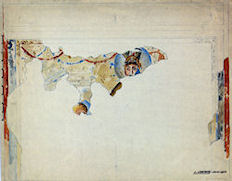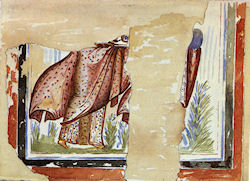PREVIOUS
NEXT
CONTENTS
HOME
Archaeological remains in Piazza della Consolazione
The lowering
of the street level in Piazza della Consolazione exposed the remains of a domus dated to the 3rd-4th century CE, near the back of the church of S. Maria della Consolazione. A rectangular room was investigated and interpreted as a nympheum,
given the presence of a marble pool fed by a lead pipe. There were also wall
paintings that had been whitewashed during the last phase of occupation. A
central image with a haloed female was interpreted as the goddess Rome (Figure
11) towards whom figures to the sides carried offerings (Figure 12; Colini 1980, 3-26).


Figure 11: Nymphaeum discovered in Piazza della Consolazione. Remains of the central image with the goddess Rome (watercolour by L. Cartocci; from Colini 1980)
Figure 12: Nymphaeum discovered in Piazza della Consolazione. Remains of the left image (watercolour by L. Cartocci; from Colini 1980)
The
discoveries also included 'i resti del podio di un tempio precipitato dall'alto
del colle' (the remains of a podium fallen off from the top of the
[Capitoline] hill), as well as statues, fragments of a frieze and of
inscriptions now stored in the Capitoline Museums (Colini 1938b, 281; 2000, 94;
Pietrangeli 1992, 70).
PREVIOUS
NEXT
CONTENTS
HOME
© Internet Archaeology/Author(s)
University of York legal statements | Terms and Conditions
| File last updated: Mon Mar 12 2012

